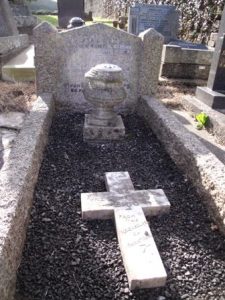Capel Heol Awst is a large Independent Welsh chapel situated off Lammas Street, at 7, Friars Park, Carmarthen. The present building dates from 1826-27 and replaced a 1726 building which itself had been enlarged in 1802 and again in 1826 to seat a congregation of 1000. It was designated as a Grade II listed building on 19 May 1981. The Chapel contains several stained glass windows, one of which serves as a War Memorial to seven members of the congregation who fell during the Great War and a further four who fell during the Second World War. The photograph of the window is courtesy of Dr Gethin Matthews, of Swansea University.
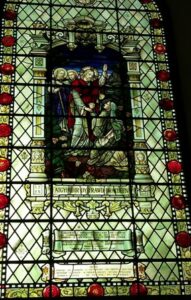
The Great War, 1914-1918
John Elwyn Davies, Private, 4299, Welsh Regiment. John was the eldest son of Evan George and Elizabeth Davies, of 8, Union Street, Carmarthen. He worked as a Solicitor’s Clerk before enlisting at Carmarthen into the 1/4th Battalion, Welsh Regiment, which was the local Territorial battalion, attached to 159 Brigade, 53rd (Welsh) Division. In July 1915 the Division embarked at Avonmouth for the Mediterranean, and landed on the Gallipoli beaches on 8 August 1915. Here, the 4th Welsh were thrown into desperate fighting over the coming days. John was wounded soon after landing, and died aboard a Hospital Ship on 13 August 1915, aged 19. He was buried at sea, and is commemorated on the Helles Memorial, Gallipoli.
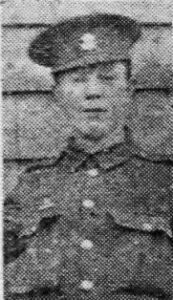
William Evan Morgan Davies, Lance Corporal, 44146, South Wales Borderers. William was the son of John and Margaret Davies, of 30, Richmond Terrace, Carmarthen. He originally enlisted into the Royal Welsh Fusiliers at Carmarthen, but was sent to France to join the 10th Battalion, South Wales Borderers, part of 115 Brigade, 38th (Welsh) Division. William probably fought with the Division at Pilckem Ridge in July 1917, and was with the Division during its move to the Armentieres sector weeks later. In April 1918 the division was sent to the Somme, to take over the line at Aveluy, north of Albert, and remained here until taking part in the great advance from 21 August 1918 onwards. William was wounded before the great offensive, and died of his wounds on 2 July 1918. He was 24 years old, and is buried at Varennes Military Cemetery, France.
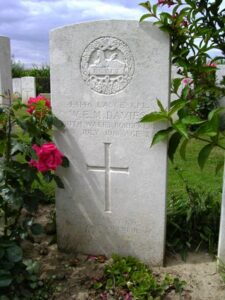
Thomas Owens, Private, 54149, Welsh Regiment. Thomas was the son of John and Elizabeth Owens, of Mount Hill Farm, Llangunnor, Carmarthen. He was residing with his brother-in-law, PC Davies, of Robinson Street, Llanelli when he enlisted at Swansea into the army. Thomas was posted out to France to join the 13th Battalion, Welsh Regiment, which had recently been moved from the Somme area, after the fighting at Mametz Wood, as part of 114 Brigade, 38th (Welsh) Division. Thomas joined the battalion while it was holding the line near Boesinghe. Thomas was wounded while the 13th Welsh were in the line at the Canal Bank. He died of his wounds on 28 February 1917, aged 36, and is buried at Mendinghem Military Cemetery, Belgium.
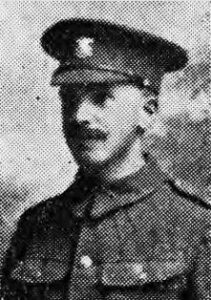
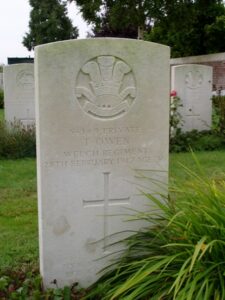
Edwin Phillips, Lance Corporal, 691, Royal Engineers. Edwin was the son of David and Rachel Phillips, of Glannant House, Oxford Street, Pontycymmer. He worked at Carmarthen for several years prior to the war, and enlisted there into the 2/1st Welsh Field Company, Royal Engineers, which was attached to the 53rd (Welsh) Division. The Division landed at Cape Helles on 9 August 1915, and was immediately plunged into heavy fighting. Edwin was killed during the Defence of Helles, on 4 December 1915. He was 30 years old, and was buried at Lala Baba War Cemetery, Gallipoli by four friends from Carmarthen.
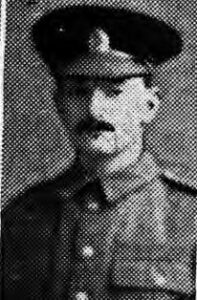
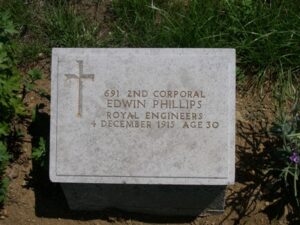
Thomas Harold Phillips, Trooper, 199, Australian Imperial Force. Thomas was born on 14 April 1889, the son of David and Sarah Phillips, of Arfryn, Carmarthen. He joined the Territorials in 1909 and served for three years as Sergeant in the 7th Welsh Cyclists. He emigrated to Australia around 1912, and at the outbreak of the war enlisted at Brisbane on 2 September, 1914, into the 2nd Light Horse, which formed part of the 1st Australian Light Horse Brigade. The regiment sailed from Brisbane on 25 September and disembarked in Egypt on 9 December 1914. The 2nd Light Horse deployed to Gallipoli without its horses and landed there on 12 May 1915, joining the New Zealand and Australian Division. Just two days later, on 14 May 1915, Thomas was badly wounded, suffering gunshot wounds to his back, and was taken aboard the Hospital Ship Gascon. He died at 13.30 that day, and was buried at sea midway between Gallipoli and Alexandria. Thomas was 26 years old, and is commemorated on the Lone Pine Memorial, Gallipoli.

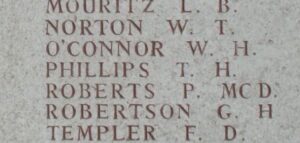
Frederick George Tansill, Private, 42156, East Yorkshire Regiment. Frederick was the son of George and Catherine Tansill, of 1, Towy Villa, Station Road, Carmarthen. He worked at the GWR Depot at Carmarthen prior to enlisting at Carmarthen into the army. He was posted to the 1/4th Battalion, East Yorkshire Regiment, which was attached to 150 Brigade, 50th (Northumbrian) Division. The Division had been in France since April 1915, and had fought at Ypres and on the Somme. During 1917 they fought at the Battle of Arras, then at Third Ypres. During March 1918 they were stationed near St. Quentin, and were hit here by the German Spring Offensive of 21 March 1918, taking part in a gallant rearguard action during the Actions at the Somme Crossings, and then at the Battle of Rosieres. After suffering terrible casualties, the Division moved north to Flanders to rest and rebuild, but in April the Germans launched an attack in Flanders, around the Lys, and the Division saw much fighting again. The battered Division was moved to a quiet sector on the Aisne to rebuild, but unfortunately the Division was hit hard by a surprise enemy attack, suffered heavy casualties. Frederick was killed on the Aisne on 8 September 1918. He was 19 years old, and is buried at St. Erme Communal Cemetery Extension, France. His elder brother William also fell.

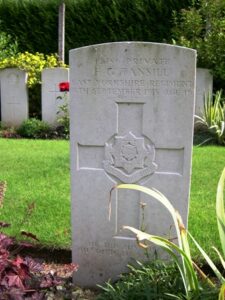
Joseph Lewis Thomas, Private, 20659, Welsh Regiment. Joseph was the son of David and Sarah Thomas of Tawelan, College Road, Carmarthen. He enlisted during March 1915 at Carmarthen, into the 15th Battalion, Welsh Regiment, which was known as the Carmarthen Pals battalion, attached to 114 Brigade, 38th (Welsh) Division. On 2 December 1915 the battalion moved to France, and the entire Division moved to the Fleurbaix sector, where it was initiated into trench warfare. During June 1916 the Division marched south to the Somme, and on 7 July 1916 attacked Mametz Wood. The initial attack failed, and it was three days later, on 10 July, that a fresh attack was mounted. After two days of heavy hand to hand fighting within the wood, the Germans withdrew, and the battered Welshmen moved via Hébuterne to Boesinghe, on the Yser Canal, where it remained until launching its attack on Pilckem Ridge on 31 July 1917. Joseph was killed at Pilckem on 1 August 1917. He was 21 years old, and is commemorated on the Ypres (Menin Gate) Memorial, Belgium.
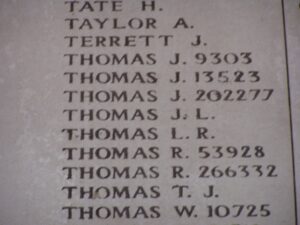
————————————————————————————————————————————————————————
World War Two, 1939-1945
Alun Meilir Davies, Private, 14635646, Parachute Regiment. Alun wwas born on 27 July 1924, the son of William Davies and Martha Davies (nee Jones), of Carmarthen, and was educated at Carmarthen Grammar School. His parents later moved to Aberystwyth. Alun enlisted into the army and became selected for the Special Forces, joining the 9th Battalion, Parachute Regiment, Army Air Corps. The battalion had formed in November 1942 from the 10th Battalion, Essex Regiment, and was assigned to the 3rd Parachute Brigade, which was initially attached to the 1st Airborne Division. In April 1943 the 1st Airborne Division left Britain to take part in the Allied invasion of Sicily, leaving the 3rd Parachute Brigade behind, then on 23 April the brigade became transferred to the newly formed 6th Airborne Division. At dawn on 6 June 1944, D-Day, the 9th Parachute Regiment left England, tasked with the capture of the famous Merville Gun Battery in Normandy, and landed around the area in gliders during the early hours of D-Day, 6 June 1944. Alun was killed during the capture of the battery that day. The 19-year-old was posted as missing, but was later deemed to have been killed in action. He has no known grave, so is commemorated on the Bayeux Memorial, France.
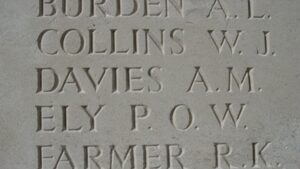
Brynmor Samuel Jones, Sergeant, 1061957, Royal Air Force Volunteer Reserve. Brynmor was born on 5 January 1916, the son of George and Eliza Jones, of 43, St. Catherine Street, Carmarthen. He worked as a clerk for the Carmarthenshire Insurance Company prior to enlisting into the Royal Air Force Volunteer Reserve, and after completing his training as an Air Gunner was posted to 57 Squadron, Royal Air Force, which was equipped with the Vickers Wellington II, based at RAF Feltwell. On the night of 15 October 1941, Brynmor took off from Feltwell aboard a Vickers Wellington IC, Serial X9978, which joined a large bomber group despatched to strike targets in Cologne. During the early hours of the following morning, 15 October 1941, the Wellington was intercepted by a German night fighter, and was shot down, crashing with the loss of all six of her crew at Grevenbicht, some five Miles Northwest of Sittard. Brynmor was 25 years old when he was killed that night and was buried alongside his fellow crewmen in Venlo British Cemetery. In August 1947 the cemetery was cleared and the war graves were re-interred in Jonkerbos War Cemetery, Netherlands.
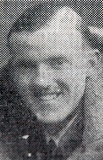
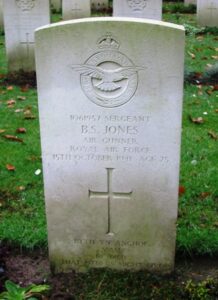
Derric Isaac Jones, Flying Officer, 120809, Royal Air Force Volunteer Reserve. Derrick was born in 1920, the son of David John Jones and Margaret Ann Jones (nee Owen), of 7, Water Street, Carmarthen. After leaving Carmarthen Grammar School he enlisted into the Royal Air Force Volunteer Reserve and after training as a Navigator/ Bomber was posted to No. 1 (Coastal) Operational Training Unit, for specialist training prior to joining a front-line squadron. At just after midnight on the morning of 10 November 1942, Derrick took off from RAF Silloth, on the Solway Firth, as Navigator of a Lockheed Hudson, Serial AM680, flown by Flight Sergeant John Frederick Saunders, on a night navigation exercise. About half an hour later the aircraft sent out a radio message, stating: ‘I will call you again later’, but nothing more was heard. The Hudson had crashed at Beda Fell near Ullswater in thick fog on 10 November 1942, bursting into flames on impact, and killing all five men aboard. The local police and the RAF sent out search parties to try and find the aircraft, and it was not until the following day that the wreckage was located. Derrick was 22 years old when he was killed during the crash. His remains were recovered from the wreckage and he was brought home for burial in Carmarthen Cemetery.
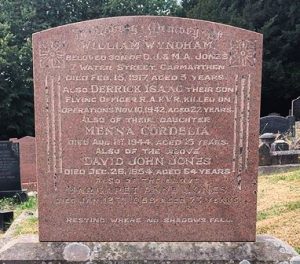
David Eric Williams, Aircraftman 2nd Class, 1047445, Royal Air Force Volunteer Reserve. David was born on 1 December 1920, the son of David Williams and Ellen Williams (nee Jones), of 16, St. Clears Road, Johnstown, Carmarthen. He worked as a Solicitor’s Clerk prior to enlisting into the Royal Air Force Volunteer Reserve and was posted to No. 1 Recruits Centre at RAF St. Athan. David became seriously ill on 16 June 1941 and was admitted to the RAF hospital at St. Athan, where he died that same day of meningitis. The body of the 20-year-old was conveyed home and he was buried in St. Luke’s Churchyard, at Llanllwch.
